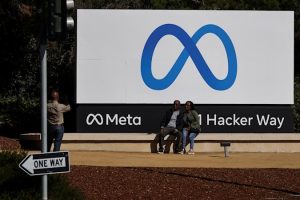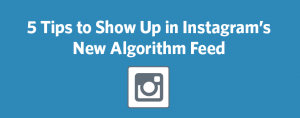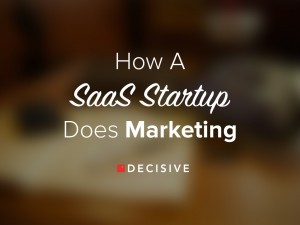Which colors of the rainbow are the best?
Based on what?
The best at what?
Blue’s a good light for coming out of TVs screens late at night. And for country songs about eyes and the Montana skies.
Red’s a good light for districts of ill-repute. Also, sunsets, roses, and clown noses.
Green is best to use for astroturf.
I mean, huh? What?
Which social media platforms are the best depends entirely on what you’re trying to do with them.
The question to ask yourself is:
Which social media platform should I use for my goals?
No matter what your business model is and no matter where you are on your content marketing journey — still deciding if you should do social media at all, already dabbling in your favorite personal channels, just lurking, or leading a focused campaign — you need to be able to say why you’re using each platform. How does it suit your needs and achieve your objectives?
Of course, this all means you need to know what your goals and objectives are. It can’t just be “because everybody else is doing it.”
You also need to know what reasonable expectations of success are on each of the platforms. Skip ahead to the second, bigger graph below if you want to know right now.
Meanwhile, what do rainbows have to do with social media?
Because I can’t resist a good tangent, I’ll take Rainbows and Social Media for 120 words.
From the relatively simple matter of whether or not it could be a double to the more complex study of the rainbow’s history and usage as a flag, what the scholars call vexillology, we can look at rainbows in relation to social media from countless angles.
Edging to the profound, we can examine how, in the immediate hours following the landmark SCOTUS ruling on marriage, rainbows swamped our feeds, symbolizing social justice, civil rights, and so much posturing.
And how, within hours of that, the social media pundits called our attention to the meta-level of these rampant rainbows, the fact that 26 million Facebook users changed their profile pics, and whether that means Zuckerberg is spying on us, again. Gasp!
Back to which one is best & the tweet that prompted this post
(With thanks to Content Marketing Institute in conjunction with Marketing Profs.)
How effective are the #socialmedia platforms that you use? http://t.co/Q0qbnbaCLZ pic.twitter.com/lAi7m0atus
— Content Marketing (@CMIContent) June 25, 2015
When I saw this nugget come across my personal Twitter feed the other day, I LOL’ed:
Geez, science much, guys?
“The Effectiveness Ratings for B2C Social Media Platforms”
Based. On. What?
With a little digging, I got the eureka moment. (Helpful hint: In today’s content rich landscape, don’t make your reader go digging for info. Don’t bury the lead.)
Based on their 5th annual content marketing survey, that’s what. You can see the whole slideshow on SlideShare. Let me save you some time — our slide is #24.
They polled a bunch of people who presumably know what they’re doing when it comes to social media and content marketing. They asked these pros, “How effective are the social media platforms that you use?” Answer choices were one through five, from meh to yeah.
But, they failed to ask: “Based on what?” For instance…
Have you found these platforms effective based on:
- Documented increase in opt-ins to receive your e-newsletter? How do you know the source of these new referrals?
- Increased sales on products and services? How do you track sales coming from social?
- Increase in site visits, page visits, and time spent on your website as referred by social platforms?
- Expanded reach for your messaging? How do you measure that?
- Anecdotal evidence of an online community coalescing around your offering?
- Improved word of mouth? How do you know?
- Opened up a new market, a new segment, or a new demographic?
- Other reasons not listed?
In other words, don’t use indicators like this one to decide which social media platform you should use for your small business, non-profit or consultancy. I know they didn’t even present it as such but my mind immediately highlighted it as a Recommendation from the Experts. They say you should watch your salt intake. They say you should drink a glass of red wine every day. (I like “them.”)
Nonetheless, it’s a useful metric for B2C marketers.
With this survey question, CMI and MP show us where the user community — business to consumer (B2C) marketing professionals — are spending their time and, likely, their ad dollars.
Their answers tell us what we already knew as private users, which is that we’re all still captive to Facebook. They tell us that marketers are increasingly confident in Instagram. Who isn’t, am I right?
And, they tell us that B2C marketers are shedding misplaced faith in LinkedIn as a platform for the marketing efforts. Look, if I’m selling consumer goods, whether they’re hand-embroidered cotton diapers or dishwashers, my best channel is not going to be the one that working people check while they’re at the office.
The other question to ask yourself is:
Which platforms drive the best engagement for state tourism agencies?
Er um, well something like that. Stay with me here.
We’re going to use that pretty specific question as a proxy for the broader notion, How well do the social media platforms perform relative to each other? Related, how will it look when my presence is succeeding?
In a recent post on iMedia Connection, Doug Schumacher writes,
One of the more challenging tasks in social media analysis is comparing performance across different social networks. Several issues contribute to the difficulty. Networks have different content formats, and resultingly, engage users differently. The have varying engagement mechanisms as part of their user interface. And can have vastly different community sizes.
But at the end of the day, you need a point of comparison.
That point of comparison is NOT whether one in five dentists chose it to give to their family. And it’s not how other marketers rated it on a scale of nothing to something. That comparison is:
[Fade in: angelic chorus]
ENGAGEMENT
[Fade out: angelic chorus]
I’m with Meg Wheatley: Whatever the problem, community is the answer. Without engagement, there is no community.
In social media, engagement is a percentage given by how many people are interacting with you from your audience. For instance, during the merry merry month of May, you had a hundred followers and twenty of them liked, commented, shared, tweeted, retweeted, asked a question, posted an answer, or otherwise interacted with you, so your engagement was 20%. Which is whopping, by the way.
Except for YouTube, which he explains in an in-graph footnote, Schumacher applies that formula (engagement = public engagements / number of posts / number of fans) to publicly available data for state tourism agencies.
Source: iMediaConnection
If you’re a beginner, I want to highlight a few things. If you’re not, you should totally geek out on this chart.
- None of the engagement percentages break double digits. Nary a one.
- Instagram alone can claim engagement rates that crack the Left Side of the Decimal Point. Which is to say, engagement on Instagram breaks low single digits. Woot.
- No offense but… These agencies are likely bigger, better funded, and more experienced in all things marketing than your small business, non-profit, or private practice. That means they probably got these numbers with the prudent use of ad monies on each channel.
- And that means these percentages probably don’t represent organic growth, which is where we “smaller fish” usually swim. Organic growth is one of those resume builder terms and a euphemism for “I didn’t have budget, so I didn’t pay for ads.” And, I still took names, if you know what I mean.
I wanted to point this out before you calculated your own engagement scores. Without setting proper expectations of what successful social media marketing looks like, your numbers might seem abysmally low.
Soon, we’ll look at which platforms are best for which goals and which audiences. It’s still like the Wild West out there in the long tail and anything’s possible, but we can shake loose some generalizations.
TOMMY — Featured image credit: Flickr user Liam Moloney, License: CC BY-SA (commercial reuse with modification)
(332)
Report Post









